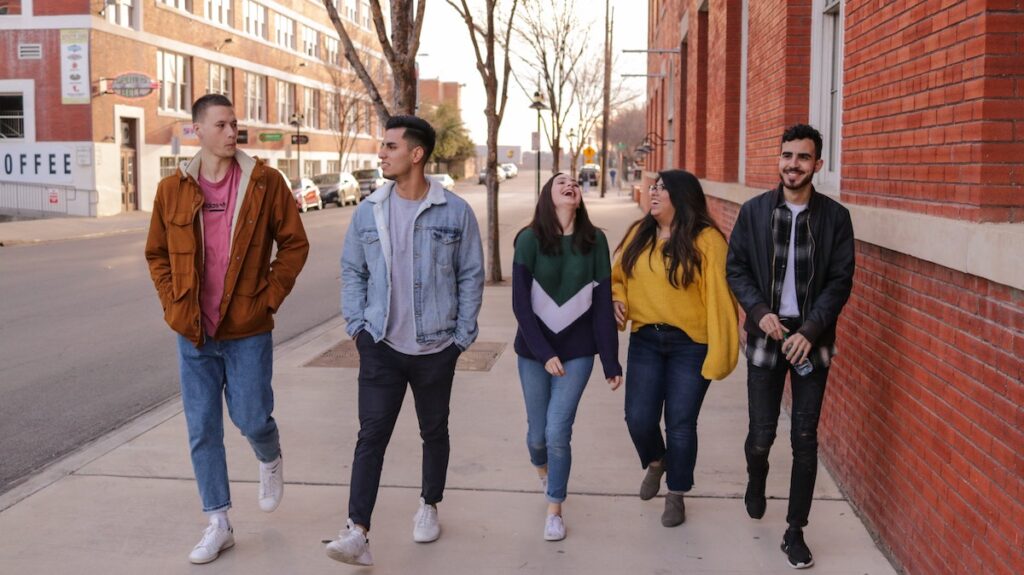
Cannabis is a popular drug: over 20% of students in the USA report using cannabis (Schulenberg et al., 2019), despite negative intrapersonal outcomes (Caldeira et al., 2012; Dager et al., 2018; Arria et al., 2015). Twin studies estimate that almost half of the risk* of cannabis initiation is due to genetics (Verweij et al., 2010), suggesting the environment is equally responsible. The genetic liability of cannabis use increases as people age (Kendler et al., 2008b), which implies that environmental influences become less important than genetic liabilities in adulthood. So-called protective environments for cannabis include participating in social activities (Correira, Benson, & Carey, 2005; Meshesha, Dennhart, & Murphy, 2015; Wasmuth, Pritchard, & Kaneshiro, 2016). Whereas, having friends who use cannabis (Agrawal et al., 2010), living on campus (O’Brien et al., 2018), and the associated social norms that come with these situations (O’brien et al., 2018; Suerken et al., 2014; Ecker, Richter, & Buckner, 2014), represent cannabis risk factors among students.
In this blog, I discuss Thomas and colleagues’ (2021) study, which aimed to understand the influence that Polygenic Risk Scores (PRS) have on cannabis initiation, and how a variety of protective and risk environments affect cannabis use in students. Thomas et al. (2021) developed several hypotheses including:
- The PRS for cannabis use, as well as deviant behaviours in peer groups, would increase the likelihood of recent cannabis use;
- The influence of PRS would become greater as students aged and when they had greater levels of peer deviance.
- The influence of PRS would become weaker the more socially engaged in community activities, students were.
* By “risk” factors, I am referring to the likelihood of cannabis initiation/use, not any associated health implications, nor am I implying that all cannabis use confers an equal risk.

Over 20% of students use cannabis and the risk of using it can be attributed to genetics and environmental influences equally.
Methods
Participants were all students attending college in the USA. Using data (GWAS) (Pasman et al., 2018), PRS for lifetime cannabis use was calculated. Thomas et al. (2021) stratified their sample into European-American (n=750) and African-American (n=405) groups. Due to the GWAS data being from individuals with European-American ancestry only, multi-ancestry PRSs were created to ensure that the GWAS data demonstrated similar genomic features as this study’s sample.
Longitudinal data were gathered from a larger study (Dick et al., 2014). Peer deviance was measured using Kendler et al.’s (2008a) questionnaire, which asks questions such as “how many of your peers have had problems with the law?”, and participants responded either none, a few, some, most, or all. Activity participation was categorised into 4 dimensions: organised sports, school activities, community activities, and church-related activities (Kendler, Gardner, & Dick, 2011). Participants were asked to respond either never, rarely, sometimes, or often. Participants self-reported cannabis use. Participants were asked about all behavioural and cannabis measures since attending college in year 1 and during each spring term for the next 3 years.
Generalised estimation equations with correlation analyses were used to investigate the hypotheses. Several two-way interaction analyses were conducted to estimate the effect that PRS had on cannabis use: PRS by time, PRS by peer deviance, and PRS by activity participation in each activity category. Any significant interactions were tested in a model that controlled for the interaction effect between each variable and covariates (age and sex).
Results
Main effects
There was no significant influence of Polygenic Risk Scores (PRS) on cannabis use. Over 40% of European-American students and over 30% of African-American students used cannabis since attending college. The mean PRS of cannabis use was not significantly different between those who did and did not use cannabis. In the African-American group, PRS was not significantly correlated with any environmental predictors. In the European-American group, PRS was positively correlated with peer deviance and negatively correlated with community activities.
Interaction effects
In both groups:
- Peer deviance was significantly associated with greater odds of cannabis use.
- Church activity participation was significantly associated with lower odds of cannabis use.
- The other behavioural measures and two-way interactions (including time) were not significantly associated with cannabis use in either group.
In the European-American group only:
- Community activity participation was significantly associated with lower odds of cannabis use. The PRS influence was lower when community participation was higher, which was not seen in the African-American group.
- The influence of PRS on cannabis use was higher when participation in organised sports was higher, which suggests that PRS has relatively no influence on cannabis use in students who rarely participate in organised sports.

Genetic risk of cannabis use does not mean an individual will definitely use cannabis in their lifetime.
Conclusions
Polygenic risks, in isolation, do not significantly influence cannabis use, which supports the idea that genetic predispositions are modifiable via the environment. Only when Polygenic Risk Score (PRS) is combined with a lack of community activity participation in European-American students, is the influence significant. Peer deviance represents the strongest environmental influencer on cannabis use in students, which suggests prevention efforts should be focused on promoting healthy and supportive social environments.

Peer deviance represents an important risk factor for cannabis use in student populations.
Strengths and limitations
This study adopted an open science model, which improves the validity of the findings by reducing biases and avoiding questionable research practices that are prevalent in some areas of psychological research. By correcting for multiple testing in the analyses, the likelihood of a type I error decreased, which exemplifies the importance of open science.
However, the self-reporting of cannabis use and responses to the behavioural measures are less than ideal. Students may be reluctant to admit true levels of cannabis use, as it was still illegal in some states when data were collected. The discovery GWAS were all European-American, which limits the generalisability of findings related to the African-American student sample. The two groups were mainly female, so whether the results can be generalised to males is unknown. Additionally, the significant finding that the influence of Polygenic Risk Scores (PRS) was higher on those who regularly engage in organised sport should be approached with caution, as significance was depleted after statistical correction, which suggests this result could be an artifact of multiple testing rather than a reliable finding. This needs to be explored in a replication study in a dissimilar sample group.
Surprisingly, mental and physical health was not assessed in any way. Mental health can significantly influence substance use, and many psychopathologies share a similar genetic background with substance use and with social traits such as impulsivity (Schuckit, 2014; Degenhardt, Hall, & Lynskey, 2001). Therefore, mental health represents an extraneous variable in this study.

Mental health factors that influence and share genetic backgrounds with drug use and social behaviour were not investigated here.
Implications for practice
Understanding how much of the risk of cannabis use can be modified via the environment is crucial to inform treatment programmes for those with problematic use and to reduce stigma. This study suggests that it would be beneficial for Universities to provide opportunities for a healthy social environment that consists of community engagement, such as those that promote a sense of belonging, as part of a package of support for students who use cannabis problematically. This study also suggests that clinical interviews and treatment plans should account for a student’s social environment, in order to be successful. Even for those without problematic use, this study helps Universities to understand how drug use trajectories change throughout student life, which could inform prevention and harm reduction efforts for those who are genetically liable for problematic drug use.

This study provides further knowledge on how universities could promote a sense of community, belonging and support to students who use cannabis.
Statement of interests
I’m a peer educator for Students for Sensible Drug Policy, a student-led grassroots organisation that advocates for evidence-based drug policy change and legalisation around the world. SSDP does not condone nor condemn drug use.
Links
Primary paper
Thomas, N. S., Salvatore, J. E., Gillespie, N. A., Aliev, F., Ksinan, A. J., Dick, D. M., & Spit for Science Working Group. (2021). Cannabis use in college: Genetic predispoitions, peers, and activity participation. Drug and alcohol dependence. 2021 219 108489.
Other references
Agrawal, A., Balasubramanian, S., Smith, E. K., Madden, P. A. F., Bucholz, K. K., Heath, A. C., & Lynskey, M. T. (2010). Peer substance involvement modifies genetic influences on regular substance involvement in young women. Addiction. 2010 105(10) 1844-1853.
Arria, A. M., Caldeira, K. M., Bugbee, B. A., Vincent, K. B., & O’Grady, K. E. (2015). The academic consequences of marijuana use during college. Psychol Addict Behav. 2015 29(3) 564-575.
Caldeira, K. M., O’Grady, K. E., Vincent, K. B., & Arria, A. M. (2012). Marijuana use trajectories during the post-college transition: health outcomes in young adulthood. Drug and Alcohol Dependence. 2012 125(3) 267-275.
Correira, C. J., Benson, T. A., & Carey, K. B. (2005). Decreased substance use following increases in alternative behaviours: a preliminary investigation. Addict Behav. 2005 30(1) 19-27.
Dager, A. D., Tice, M. R., Book, G. A., Tennen, H., Raskin, S. A., Austad, C. S., Wood, R. M., Fallahi, C. R., Hawkins, K. A., & Pearlson, G. D. (2018). Relationship between fMRI response during a nonverbal memory task and marijuana use in college students. Drug and Alcohol Dependence. 2018 188 71-78.
Degenhardt, L., Hall, W., & Lynskey, M. (2001). Alcohol, cannabis and tobacco use among Australians: a comparison of their associations with other drug use and disorders, affective and anxiety disorders, and psychosis. Addiction. 2001 96(11) 1603-1614.
Dick, D. M., Nasim, A., Edwards, A. C., Salvatore, J. E., Cho, S. B., Adkins, A., Meyers, J., Yan, J., Cooke, M., Clifford, J., Goyal, N., Halberstadt, L., Ailstock, K., Neale, Z., Opalesky, J., Hancock, L., Donovan, K. K., Sun, C, Riley, B., & Kendler, K. S. (2014). Spit for science: launching a longitudinal study of genetic and environmental influences on substance use and emotional health at a large US university. Front Genet. 2014 5 47.
Ecker, A. H., Richter, A. A., & Buckner, J. D. (2014). Cannabis-related impairment: the impacts of social anxiety and misconceptions on friends’ cannabis-related problems. Addict Behav. 2014 39(12) 1746-1749.
Kendler, K. S., Schmitt, E., Aggen, S. H., & Prescott, C. A. (2008b). Genetic and environmental influences on alcohol, caffeine, cannabis, and nicotine use from early adolescence to middle adulthood. Arch Gen Psychiatry. 2008 65(6) 674-682.
Kendler, K. S., Gardner, C., & Dick, D. M. (2011). Predicting alcohol consumption in adolescence from alcohol-specific and general externalising genetic risk factors, key environmental exposures and their interaction. Psychol Med. 2011 41(7) 1507-1516.
Meshesha, L. Z., Dennhardt, A. A., & Murphy, J. G. (2015). Polysubstance use is associated with deficits in substance-free reinforcement in college students. J Stud Alcohol Drugs. 2015 76(1) 106-116.
O’Brien, F., Simons-Morton B., Chaurasia, A., Luk, J., Haynie, D., Liu, D. (2018). Post-high school changes in tobacco and cannabis use in the United States. Subst Use Misuse. 2018 53(1) 26-35.
Pasman, J. A., Verweij, K. J. H., Gerring, Z., Stringer, S., Sanchez-Roige, S., Treur, J. L., Abdellaoui, A., Nivard, M. G., Baselmans, B. M. L., Ong, J-S., Ip, H. F., van der Zee, M. D., Bartels, M., Day F. R., Fontanillas, P., Elson, S. L., de Wit, H., Davis, L. K., MacKillop, J., Derringer, J. L., et al. (2018). GWAS of lifetime cannabis use reveals new risk loci, genetic overlap with psychiatric traits and a causal influence of schizophrenia. Nat Neurosci. 2018 21(9) 1161-1170.
Schukit, M. A. (2014). A brief history of research on the genetics of alcohol and other drug use disorders. J Stud Alcohol Drugs Suppl. 2014 75 59-67.
Schulenberg, J. E., Johnston, L., O’Malley, P., Bachman, J., Miech, R., & Patrick, M. (2019). Monitoring the Future National Survey results on drug use: College students and adults ages 19-55. Volume II. Institute for Social Research. 2018.
Suerken, C. K., Reboussin, B. A., Sutfin, E. L., Wagoner, K. G., Spangler, J., & Wolfson, M. (2014). Prevalence of marijuana use at college entry and risk factors for initiation during freshman year. Addict Behav. 2014 39(1) 302-307.
Verweij, K. J. H., Zietsch, B. P., Lynskey, M. T., Medland, S. E., Neale, M. C., Martin, N. G., Boomsma, D. I., & Vink, J. M. (2010). Genetic and environmental influences on cannabis use initiation and problematic use: a meta-analysis of twin studies. Addicion. 2010 105(3) 417-430.
Wasmuth, S., Pritchard, K., & Kaneshiro, K. (2016). Occupation-based intervention for addictive disorders: a systematic review. J Subst Abuse Treat. 2016 62 1-9.
Photo credits
- Photo by Nick Harsell on Unsplash
- Photo by Eliott Reyna on Unsplash
- Photo by LinkedIn Sales Solutions on Unsplash
- Photo by Sangharsh Lohakare on Unsplash
- Photo by Richard Cabusao on Unsplash
